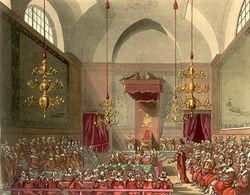Precedence: Difference between revisions
No edit summary |
|||
| Line 178: | Line 178: | ||
* [[Barony of Sterne|Sterne]] (unknown) (subsidiary of the [[Earldom of Essex]]) | * [[Barony of Sterne|Sterne]] (unknown) (subsidiary of the [[Earldom of Essex]]) | ||
* [[Barony of Wadebridge|Wadebridge]] (unknown) | * [[Barony of Wadebridge|Wadebridge]] (unknown) | ||
[[Category:Lists]] | |||
Revision as of 19:14, 17 January 2017

The oldest of the actual ranks of the peerage are Dukedoms Earldoms and Baronies. The first RL recorded Marquessate was in 1385, the first RL Viscountcy was created in 1440. (JFYI) The older the title, the more likely it is to have lapsed and been recreated further down the line, IRL. The order of precedence works: Royalty, Dukedoms, Marquessates, Earldoms, Viscountcies, Baronies.
The date of creation gives the precedence within each rank, and they can be further reordered depending on which peerage the rank belongs to. The ranking of peerages is:
- of England (titles created before 1707)
- of Scotland (titles created before 1707)
- of Ireland titles created before 1707)
- of Great Britain (titles created between 1707 and 1801)
- of the United Kingdom (titles created after 1801)
An earl in the Irish peerage whose title dates from, say, 1692 comes after an earl in the English peerage whose title dates from 1702. I have tried to include the main titles used in LL, and where a date of creation is unknown, they are listed in alphabetical order after the last known date of creation of that rank, with presumed English titles coming before known Sottish and Irish ones, to make it easier to fit them in once a date of creation for that title has been decided.
Subsidiary titles are given as bullet points below the highest-ranking title held by the family and are only listed again in the appropriate area if currently held as a courtesy title (eg the Viscountcy of Surrey is listed under Viscountcies as well as a subsidiary of the Earldom of Rotherham, as there is a son who uses that title as if it were an actual peerage). Please note that Viscounts and Barons do not have subsidiary titles; their sons are styled 'Honourable' (as are the younger sons of Earls - Robert Vickery is officially the Honourable Robert Vickery; Colonel Fitzgerald, younger son of the Earl of Rotherham, would be Colonel the Honourable Robert Fitzgerald).
This is very much a work in progress
Duchies
Claitonborough (November 4, 1479 )
- Marquessate of Pangbourne (1479)
- Earl of Pangbourne (1383)
- Viscount Whitchurch (1383)
- Baron Dunford of Pangbourne (1312)
Welby (August 24, 1503)
Wycombe (1543 )
- Marquessate of Ramsden (unknown)
Pennington (1664)
- Marquessate of St Elvan (1721, Great Britain)
- Earldom of St Elvan (1567, of England)
- Earldom of Emers (1701, of England)
- Viscountcy of Portan (1721, Great Britain)
- Barony of Penton Mewsey (1526, of England) (This is the title used by the grandson of the Duke, if there is one)
Beaumont (of England; unknown creation date)
Leicester (unknown)
- Marquessate of Spalding (unknown)
Leighton (unknown)
- Marquessate of Inverloch
Marquessates
Crantock (1489)
- Baron Treville of Crantock
Eastborough (1497)
- Earldom of Alderhan (1497)
- Barony of Eastborough (1086)
Emerson (1590)
- Earldom of Emerson (1408)
- Viscountcy of Morton (1354)
Coniston (1664)
- Viscountcy of Milbury (1689)
Beningborough (September 24, 1704 )
- Earldom of Seyton (September 1, 1485 )
Raulings (March 2, 1746 )
- Earldom of Bridgeton (1622)
- Viscountcy of Grafton (1622)
Avening (unknown, presumed English)
Hollomere (unknown, presumed English)
Pendleston (unknown, presumed English)
- Viscountcy of Stanwood (unknown)
Spalding (date unknown, English) (subsidiary of the Duchy of Leicester)
Wadham (unknown, English)
Marquessate of Foxford (Irish) (1681)
- Earldom of Galbraith (unknown)
Earldoms
Earldom of Emerson (1408) (subsidiary to the Marquessate of Emerson
Seyton (1485) (subsidiary to the Marquessate of Beningborough)
Alderhan (1497) (subsidiary of the Marquessate of Eastborough)
Rotherham (1579)
- Viscountcy of Surrey (1356 )
Essex (1616)
Bridgeton (1622) (subsidiary of the Marquessate of Raulings)
- Viscountcy of Grafton (1622)
Morven (1660)
- Viscountcy of Selwyn (1712 ) (Peerage of Great Britain)
Prestwood (May 13th, 1692 )
Carrington (unknown date, of Great Britain)
Griffith (unknown)
- Viscountcy of Torrington (unknown)
Thernope (unknown, presumed 'of England')
Winchcombe (date unknown, presumed 'of England')
Wyck (unknown, presumed 'of England')
Hopetoun (unknown, presumed 'of Scotland')
Kirkfries (1745) (Peerage of Great Britain)
Parry (1791) (Peerage of Great Britain)
- Barony of Loseley (unknown but ancient)
Viscountcies
Note: A viscount is always 'Viscount Saltash' in the English peerage. He is only 'Viscount of Livingston' if the title is Scottish. Viscounts do not have any subsidiary titles, all sons being titled 'The Honourable' (as younger sons of Earls are, and as all Barons' sons are. All daughters are also styled 'The Honourable', as are Barons' daughters.)
Morton (1354) (Subsidiary of the Marquessate of Emerson)
Surrey (1356) (Subsidiary of the Earldom of Rotherham)
Grafton (1622) (subsidiary of the Marquessate of Raulings)
Wembury (9th November 1640)
Flemming (1689)
Saltash (17th October 1706)
Selwyn (1712) (Peerage of Great Britain) (subsidiary of the Earldom of Morven)
Ruxburgh (1759) (Peerage of Great Britain)
Banbury (unknown)
Delamere (unknown)
Fletstone (unknown)
Hawksley (unknown)
Lattisley (unknown)
Tessington (unknown)
Torrington (unknown) (subsidiary of the Earldom of Griffith)
Louisburgh(unknown) (Irish)
Baronies
- Ackland (March 29, 1299 )
- de Grave (unknown, probably 14th or 15th century)
- Braylock (1788, Peerage of the United Kingdom)
- Bartram (unknown, possibly after the Restoration)
- Bathurst (unknown)
- Barony of Kirkham (unknown)
- Louth (unknown)
- Sterne (unknown) (subsidiary of the Earldom of Essex)
- Wadebridge (unknown)